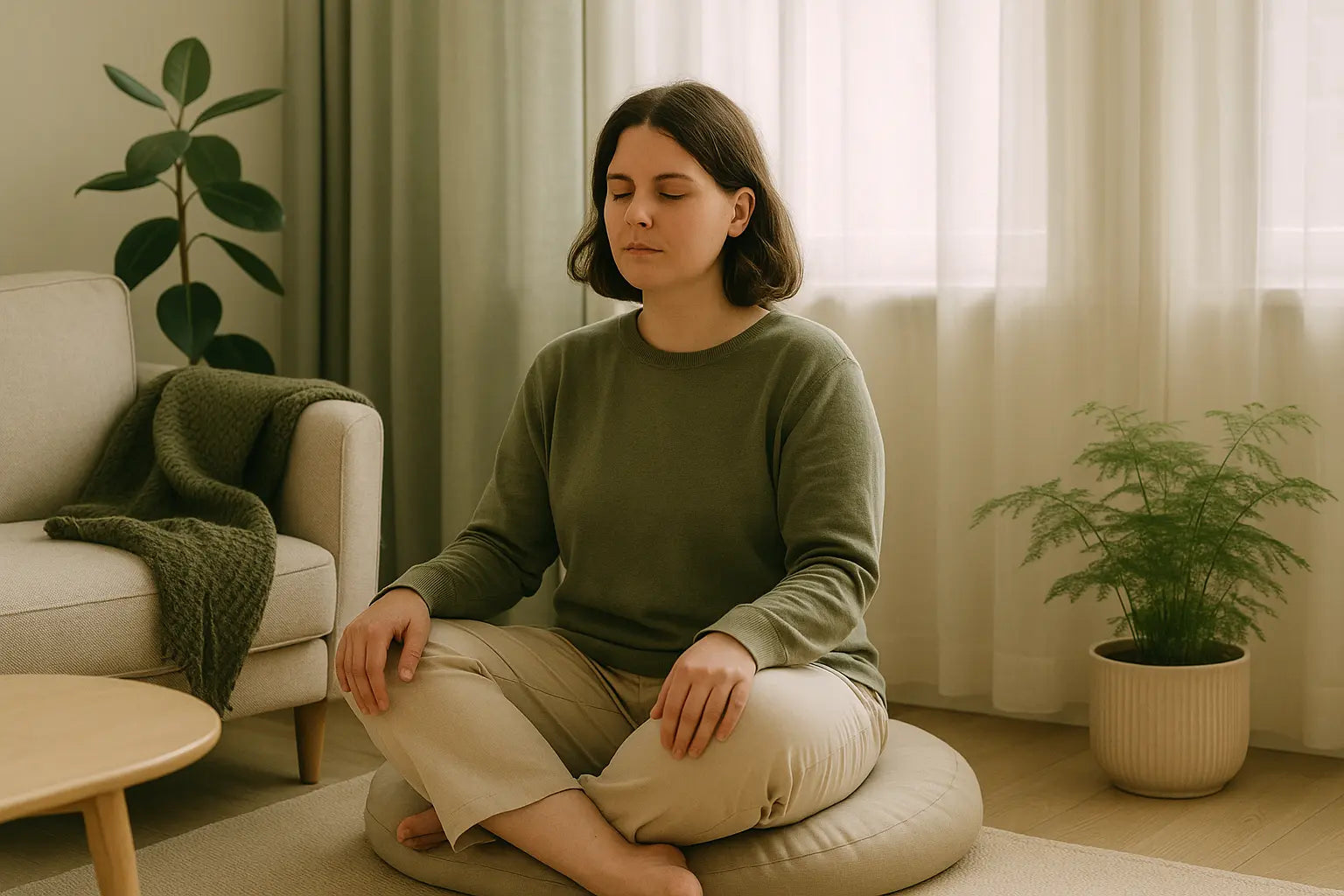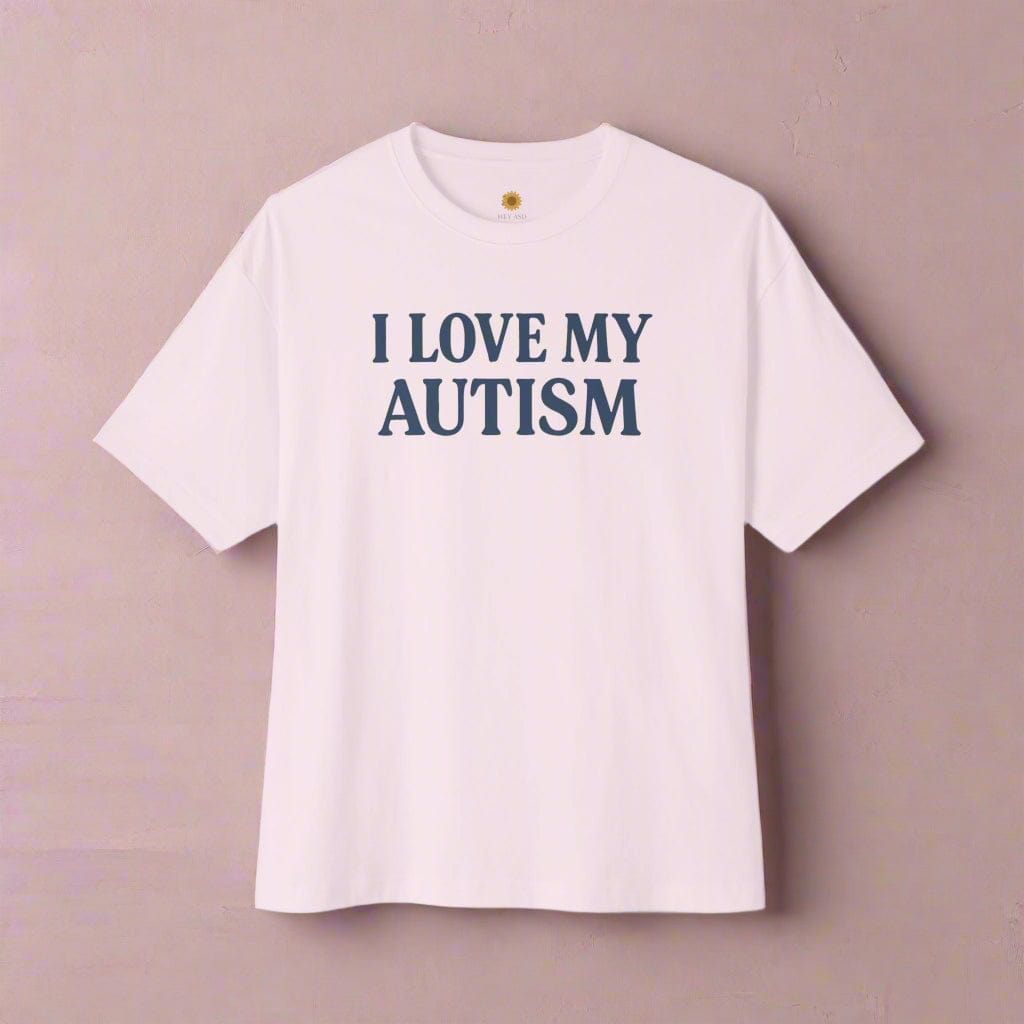Transcendental Meditation & Autism: A Gentle Path to Calm and Connection

Written by the HeyASD Editorial Team
For many autistic adults, stillness can feel both healing and hard. The world rarely slows down — full of noise, movement, and moments that demand more energy than we have to give. Finding quiet within that chaos can seem impossible.
Transcendental Meditation offers a different kind of stillness — one that doesn’t force silence, but invites rest. It’s not a cure or a fix, but a gentle way to reconnect with yourself, soothe an overstimulated nervous system, and rediscover calm on your own terms. In a world that often feels too loud, this simple practice can become a quiet act of self-care and reclamation.
Understanding Transcendental Meditation & Autism
Many autistic adults look for gentle practices that support steadier days. Transcendental Meditation (TM) is one option: a simple, mantra-based technique taught by certified instructors that invites the mind and body to settle. It isn’t a treatment for autism or a “fix.” Think of it as a tool for self-regulation, self-connection, and nervous-system calm.
What matters most is comfort and choice. Adapt the practice to your sensory needs—shorter sessions, low lighting, soft textures, permission to stim. If you’re curious, begin small, notice how your body feels before, during, and after, and fold what works into your existing self-care routines.
What Is Transcendental Meditation? Foundations and Method
Transcendental Meditation is a simple, natural technique founded by Maharishi Mahesh Yogi. The practice typically involves sitting comfortably with your eyes closed for about 20 minutes, twice a day. It is not tied to a specific religion or philosophy and is accessible to people from all backgrounds.
The core of the Transcendental Meditation technique is the silent use of a mantra. This isn't about concentrating hard or emptying your mind. Instead, the mantra is a tool that allows your mind to naturally settle into a state of deep relaxation and quiet time, a state often called transcendence.
If you are autistic and want to start, the process begins with finding a certified teacher who can provide you with a specific mantra and proper instruction. The focus is on effortlessness, allowing the mind and body to rest deeply without trying to control your thoughts. This gentle approach can make it a more inviting practice.
How TM Differs From Mindfulness and Other Relaxation Techniques for Autism
It's helpful to understand that not all meditation is the same, especially when seeking relaxation techniques that work for autistic people. While many methods exist, TM has a distinct approach that sets it apart from practices like mindfulness. This is not a treatment for autism, but a tool for self-regulation.
Mindfulness meditation often involves "open monitoring," where you pay attention to your thoughts, feelings, and bodily sensations without judgment. You are observing the contents of your mind.
In contrast, Transcendental Meditation is designed to be automatic and effortless. It uses a mantra to allow the mind to move beyond thought itself. Key differences include:
-
Focus: Mindfulness often directs focus toward the breath or body, while TM uses a mantra to allow the mind to settle inward.
-
Goal: The goal of mindfulness is often present-moment awareness, whereas TM aims for a state of "transcendence," or deep, restorative rest.
-
Effort: TM is described as effortless, differing from some concentration-based practices that require more mental control.
Navigating Sensory Overload and Internal Restlessness in Meditation
The idea of sitting still and quiet can feel daunting for many autistic adults. Sensory sensitivities can make you hyper-aware of every sound, light, or texture, while internal restlessness can make it hard to settle down. These are valid experiences, not failures in your ability to meditate.
Understanding these challenges is the first step toward finding a practice that fits you. Instead of forcing a rigid method, you can adapt meditation to honor your needs, creating a calm routine that feels supportive rather than stressful.
Sensory Challenges Faced by Autistic Adults During Meditation
For autistic people of all ages, the very act of meditating can bring unique sensory challenges to the surface. An autistic brain often processes sensory information with greater intensity, which can make a quiet room feel surprisingly loud. This is a key consideration for stress management.
The pressure to "empty the mind" can also create anxiety, leading to a cycle of frustration. Your mind might feel more active than ever when you try to quiet it. This intense internal world is a common experience and adapting your approach to emotional regulation is key.
Some specific challenges you might encounter include:
-
Hyper-perception: Heightened awareness of sounds, lights, or the feeling of your clothes can become distracting.
-
Internal Restlessness: A strong urge to move, fidget, or stim can make it difficult to remain still.
-
Alexithymia: Difficulty identifying and describing your internal emotional state can make "checking in" with yourself confusing.
Adapting Calm Routines and Environments for Accessibility
Creating a practice that feels good is more important than following strict rules. For the practice of Transcendental Meditation to be a tool for relaxation, it must be accessible. This is especially true for autistic people, including children, who benefit from predictability and comfort.
You have permission to adapt your meditation space and routine to fit your sensory profile. The goal is to reduce barriers, not create more of them. Think about what truly helps your nervous system feel safe. This might mean using items from our autism store, like sensory blankets, to create a feeling of security.
Here are a few ways to adapt the practice for yourself or an autistic child:
-
Create a Sensory Haven: Use low lighting, noise-canceling headphones, or a weighted blanket to create a calming environment.
-
Start Small: Begin with sessions as short as 2-5 minutes and gradually increase the time as you feel comfortable.
-
Allow Movement: Give yourself or your child permission to stim gently or rock during meditation if it's soothing.
Potential Benefits of Transcendental Meditation for Autistic Adults
While TM is not a way to change the core symptoms of being autistic, it may offer significant benefits that improve your overall quality of life. Many autistic adults explore meditation as a tool for managing the stress that comes from navigating a world not built for them.
The practice can be a powerful aid for emotional regulation, helping you create a space between a trigger and your response. This can lead to a greater sense of inner calm and control, making daily challenges feel more manageable.
Enhancing Stress Management and Emotional Regulation
For autistic people, daily life can involve high levels of stress. The constant effort of processing sensory information and navigating social interactions can be exhausting. Transcendental Meditation offers a direct and simple technique for stress management by inducing a state of deep rest.
This deep rest helps calm the body’s stress response. Research has shown that TM can reduce anxiety and even help lower blood pressure. By giving your nervous system a regular break, you may find that you have more capacity for emotional regulation throughout the day.
This practice can help by:
-
Reducing Anxiety: It provides a reliable way to access a calm state of mind.
-
Improving Emotional Control: It helps you develop greater self-awareness and manage emotional responses.
-
Easing Social Stress: A calmer inner state can make social interactions feel less overwhelming.
Supporting Sensory Regulation and Interoceptive Awareness
Sensory regulation is a constant balancing act for many autistic people. TM can provide a foundation for this by promoting relaxation and reducing the feeling of sensory overload. When your nervous system is calmer, you may feel less reactive to external stimuli.
The practice also enhances interoceptive awareness—your ability to understand your body’s internal cues. By sitting quietly and allowing your mind to settle, you can become more attuned to signals of hunger, fatigue, or stress before they lead to autistic burnout. This self-knowledge is empowering.
TM may support you by:
-
Calming the Nervous System: Reducing the baseline level of sensory stress.
-
Improving Focus: Cultivating a focused state of mind, which is also beneficial for those with co-occurring attention deficit hyperactivity disorder (ADHD).
-
Building Self-Awareness: Helping you recognize your own needs more clearly, which can indirectly support social skills.
Safe and Sensory-Friendly TM Practice Guide
Starting a Transcendental Meditation program should feel safe and supportive. For autistic people, this means adapting the TM technique to be sensory-friendly from the very beginning. Your comfort is the priority, and there is no right or wrong way to make the practice work for you.
This guide is designed to help you create a meditation routine that honors your unique sensory needs. By making a few simple adjustments, you can transform your TM sessions into a truly restorative experience.
Step-by-Step: Making Meditation Comfortable and Adaptive
The goal of the TM technique is deep relaxation, so your practice should feel comfortable, not forced. Making the process accessible is key, whether you are an autistic adult practicing on your own or a caregiver supporting an autistic child.
Start by creating an environment that signals safety to your nervous system. This might mean dimming the lights, putting on your favorite soft autism hoodie, or wrapping yourself in a weighted blanket.
The process is simple and can be broken down into a few adaptive steps. Remember to be patient with yourself as you find what works.
|
Step |
Adaptation for Accessibility |
|---|---|
|
Find a Space |
Choose a quiet, comfortable spot where you won't be interrupted. |
|
Get Comfortable |
Sit in a supportive chair with your feet on the floor. You don't need to sit cross-legged. |
|
Close Your Eyes |
Gently close your eyes. If this is uncomfortable, you can keep a soft, unfocused gaze. |
|
Use Your Mantra |
Begin thinking your mantra silently and easily, as taught by a certified TM teacher. |
|
Let Go |
Don't try to control thoughts. When you notice you're not on the mantra, gently return to it. |
Permission to Stim, Option to Shorten Sessions, and Using Auditory Guidance
In recent years, there's been a growing understanding that meditation practices must be flexible to support autistic people. One of the biggest challenges that can arise is the pressure to be perfectly still. You have full permission to stim.
Stimming is a natural and valid form of self-regulation. If gentle rocking, hand-flapping, or using a fidget helps you settle, then it is a welcome part of your practice. The goal is comfort, not conformity.
To further adapt the practice for sensory sensitivities, consider these options:
-
Shorten Sessions: The standard 20 minutes can feel too long at first. Start with 5 minutes and build up slowly.
-
Use Auditory Guidance: While TM is silent, some meditation traditions use chanting. The rhythmic nature of a mantra can be a form of auditory guidance that helps focus a restless mind.
-
Embrace Your Needs: Your meditation practice is for you. There is no test to pass.
Scientific Perspectives: Research on TM Therapy for Autism
Scientific research on how a Transcendental Meditation program impacts people on the autism spectrum is still an emerging field. However, early studies and pilot programs are showing promising results. Organizations like the David Lynch Foundation have helped fund research to explore how TM can reduce stress and improve quality of life for autistic children.
While more large-scale studies are needed, the existing evidence suggests that the TM technique can be a valuable tool. The focus of this research is not on "fixing" autism but on providing an effective way to manage anxiety and enhance well-being.
Evidence, Limitations, and Insights From Studies on Meditation for Autism
Scientific studies exploring meditation as an effective tool for autistic people are growing. A review of potential therapies published in Autism Research and Treatment highlighted meditation as a worthy approach for relieving clinical symptoms and improving relaxation.
Most of the research on TM and autism has involved small-scale pilot studies. For example, a project with the David Lynch Foundation taught TM to autistic children and reported noticeable benefits, including reduced anxiety and a greater willingness to try new tasks. These findings suggest TM is a feasible and beneficial practice.
However, it is important to acknowledge the limitations. Many studies are small, and more rigorous, large-scale research is needed to draw firm conclusions.
|
Study Insight |
Finding |
|---|---|
|
Stress & Anxiety |
Participants frequently report marked reductions in stress and anxiety. |
|
Behavioral Changes |
Some studies note improvements in emotional outbursts and sleep issues. |
|
Family Impact |
When a child's stress decreases, caregivers often report lower stress levels as well. |
Integrating Lived Experiences and Autistic Voices
Beyond the data, the lived experiences of autistic people offer the most meaningful insights. Many parents and caregivers in the United States have shared powerful stories about the positive changes they've seen after introducing TM.
One mother shared an excerpt about her son's experience in a project report from the David Lynch Foundation. She said, "He had previously wanted to hug, finding the resulting emotions too confusing and anxiety-provoking. Shortly after starting TM, he gave me the second spontaneous hug - ever. It blew me away!"
It is also important to honor that experiences are mixed. Some autistic people find deep peace in meditation, while others find it uncomfortable or overstimulating. The autistic community is not a monolith, and what works for one person may not work for another. Exploring resources like the HeyASD autism app can help you connect with a community and find what resonates.
Key Takeaways: Transcendental Meditation & Autism
- Transcendental Meditation (TM) offers a gentle, non-judgmental way to calm the nervous system — not a cure, but a supportive tool.
- Stillness can feel hard for autistic adults; sensory-safe adaptations like soft textures, dim lighting, or gentle movement can make practice more accessible.
- Short sessions count — even two to five minutes of calm repetition can ease stress and support emotional regulation.
- TM differs from mindfulness by using a mantra that allows the mind to settle naturally, without pressure to “empty your thoughts.”
- Comfort comes first — meditation should honor your sensory needs and offer peace on your own terms, not someone else’s rules.
Conclusion
In conclusion, transcendental meditation offers a unique approach for autistic adults navigating the complexities of sensory overload and emotional regulation. By prioritizing comfort and adaptability in your practice, you can harness the potential benefits of TM without pressure or discomfort.
Remember, meditation should be a tool for self-connection and empowerment, not a rigid standard to meet. Embrace the journey of exploring what truly calms your nervous system and supports your well-being. If you're curious to learn more about how TM can fit into your life, schedule a free consultation with our experts.
Calm Isn’t Silence — It’s Comfort in Your Own Rhythm
Explore soothing tools that support your sensory needs — from sensory blankets to sensory-friendly apparel — each designed by autistic adults for everyday calm.
Explore What Brings CalmFrequently Asked Questions
Is transpire in transcendental meditation a drug-free therapy option for autistic adults?
Yes, Transcendental Meditation is a drug-free, self-directed technique that can be a complementary therapy for autistic adults. It is not a treatment for autism but a tool for managing stress and enhancing well-being. It focuses on deep relaxation rather than disease control, helping to improve quality of life.
What challenges may arise for autistic people when practicing TM?
Autistic people practicing the TM technique may face challenges due to sensory sensitivities, making stillness difficult. Internal restlessness and the pressure to quiet the mind can also be frustrating. These are not behavioral challenges but valid responses that can be navigated by adapting the practice to individual needs.
Can meditation practices be tailored for children and adults on their own terms?
Absolutely. A Transcendental Meditation program can be tailored for autistic children and autistic adults. This includes shortening session times, allowing for stimming, and creating a sensory-friendly environment. The key is to introduce new things with patience and flexibility, ensuring the practice feels safe and supportive.
What are the benefits of Transcendental Meditation for individuals with autism?
For autistic people, Transcendental Meditation can offer numerous benefits. These may include reduced stress, improved emotional regulation, better focus, and enhanced overall quality of life. By fostering inner calm, it can also indirectly support social skills by making interactions feel less overwhelming.
How can Transcendental Meditation help reduce anxiety and stress in autistic individuals?
The Transcendental Meditation technique helps reduce anxiety and stress by giving the mind and body a source of deep rest. This period of quiet time calms the nervous system, lowering stress hormones. For autistic people, this regular practice provides a reliable tool for stress management and inner peace.
Are there specific techniques within Transcendental Meditation that are particularly effective for those on the autism spectrum?
The core TM technique—the effortless use of a mantra to allow the mind to experience transcendence—is the same for everyone. Its simplicity and lack of forced concentration are what make it particularly effective for many on the autism spectrum, including those with co-occurring ADHD, as it doesn't require "emptying" the mind.
How can parents or caregivers introduce Transcendental Meditation to an autistic child?
Caregivers in the United States and elsewhere can introduce Transcendental Meditation to an autistic child by working with a certified teacher. Start with short sessions in a calm space, use visual aids, and be patient. The goal is relaxation, so making the experience positive and predictable is key.



















